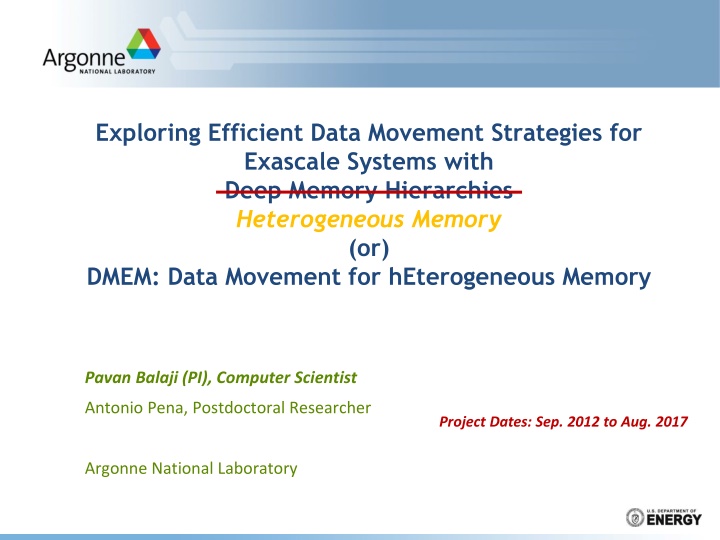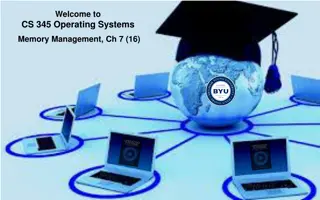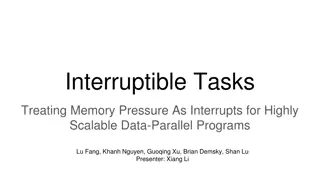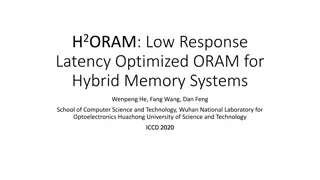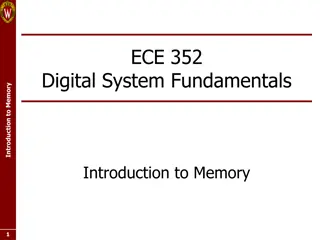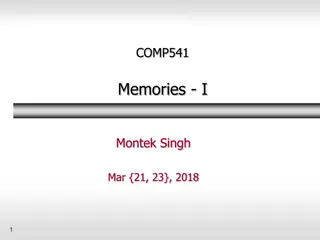Efficient Data Movement Strategies for Exascale Systems with Memory
Data movement in heterogeneous memory systems is the focus of this research project led by Pavan Balaji at Argonne National Laboratory. Exploring the complexities of different memory types and architectures, the project aims to address the challenges of efficient data motion and management. Case studies highlight the importance of utilizing diverse memory regions for various scientific applications like computational chemistry and nuclear physics.
Download Presentation

Please find below an Image/Link to download the presentation.
The content on the website is provided AS IS for your information and personal use only. It may not be sold, licensed, or shared on other websites without obtaining consent from the author.If you encounter any issues during the download, it is possible that the publisher has removed the file from their server.
You are allowed to download the files provided on this website for personal or commercial use, subject to the condition that they are used lawfully. All files are the property of their respective owners.
The content on the website is provided AS IS for your information and personal use only. It may not be sold, licensed, or shared on other websites without obtaining consent from the author.
E N D
Presentation Transcript
Exploring Efficient Data Movement Strategies for Exascale Systems with Deep Memory Hierarchies Heterogeneous Memory (or) DMEM: Data Movement for hEterogeneous Memory Pavan Balaji (PI), Computer Scientist Antonio Pena, Postdoctoral Researcher Project Dates: Sep. 2012 to Aug. 2017 Argonne National Laboratory
System Architecture Complexity Processor heterogeneity is a well known issue Heavy weight general purpose cores Light weight accelerator cores No branch prediction In-order instructions Memory heterogeneity: step- child of the heterogeneous computing era Main memory Scratchpad memory Nonvolatile memory Memory reliability and performance variation (because of power constraints) Pavan Balaji, Argonne National Laboratory XStack PI Meeting (03/22/2013)
Managing Heterogeneous Memory Core problem being addressed: Heterogeneous memory is inevitable all upcoming supercomputers use this in some way or another Applications need to make the leap from using legacy main memory to richer memory domains such as NVRAM, scratchpad memory, accelerator memory, etc. Abstract architectural model: Our view of the system architecture focuses on utilizing different memory systems as directly accessible regions Goals: Each memory has semantic differences that need to be addressed; we want to provide fundamental models for interacting with such memory Efficient end-to-end data motion from any memory to any memory (possibly across coherence domains) Moderated load/store accesses to memory (where applicable) Core Cache Main Memory NVRAM Disk Hierarchical Memory View Scratchpad Memory Main Memory Core Less Reliable Memory NVRAM Accelerator Memory Compute-capable Memory Heterogeneous Memory as First-class Citizens Pavan Balaji, Argonne National Laboratory XStack PI Meeting (03/22/2013)
Applications and Heterogeneous Memory: Case Studies Several applications are already looking at utilizing different types of memory regions Computational Chemistry Iterative convergence models allow most iterations to tolerate (infrequent) errors Same concept used in 32-bit/64-bit mixed precision computations Nuclear Physics Green s Function Monte Carlo simulations rely on large per-process memory footprints for their computations Current computations treat memory as uniform read/write performance units With NVRAM, scientists are considering modifying their algorithms to make them more read-intensive A. E. DePrince, III and J. R. Hammond J. Chem. Theory Comput. 7, 1287 (2011) "Coupled Cluster Theory on Graphics Processing Units I. The Coupled Cluster Doubles Method." Pavan Balaji, Argonne National Laboratory XStack PI Meeting (03/22/2013)
Programming Environments in the Heterogeneous Memory Era Memory fragmentation is inevitable Already seen with accelerator memory and scratchpad regions Applications are already embracing heterogeneous memory while taking advantage of the characteristics of each memory domain Programming environments are, unfortunately, falling behind We tend to treat main memory as a special memory region, where the primary computation is performed Data movement and coordination is staged in main memory because of this view that main memory is superior in some way Computation relies on the characteristics of main memory for algorithmic choices Similar read/write performance Memory consistency semantics Reliability semantics Pavan Balaji, Argonne National Laboratory XStack PI Meeting (03/22/2013)
Challenges and Opportunities Applications Runtime Management Nuclear Physics Chemistry Biology End-to-End Data Movement Programming Constructs Programming Constructs Data Memory Consistency Semantics Data Motion Description Introspection Tools Residence Annotations Heterogeneous Memory Semantics Runtime Performance/Power Management Consistency Weak Memory Consistency Integrated Data Movement Memory Reliability Management Reliability Power/Energy Efficiency Introspection Tools Hardware Simulators DOE Accelerators CODEX Leadership Machines Pavan Balaji, Argonne National Laboratory XStack PI Meeting (03/22/2013)
Everyone is a First-Class Citizen Less Reliable NVRAM Main Memory Main Memory Process Process Scratchpad NVRAM Less Reliable NVRAM Main Memory Main Memory Process Process Scratchpad NVRAM We envision an environment where all memory regions are first-class citizens, and a runtime system that provides for efficient data placement, and data movement capabilities Pavan Balaji, Argonne National Laboratory XStack PI Meeting (03/22/2013)
Example Heterogeneous Architecture: Accelerator Clusters Graphics Processing Units (GPUs) GPU Many-core architecture for high performance and efficiency (FLOPs, FLOPs/Watt, FLOPs/$) Multiprocessor CPU MPI rank 0 MPI rank 1 Programming Models: CUDA, OpenCL, OpenACC MPI rank 2 MPI rank 3 Shared memory Explicitly managed global memory and separate address spaces CPU clusters Main memory Global memory MPI based DRAM to DRAM communication PCIe Host memory only Disjoint Memory Spaces! NIC Pavan Balaji, Argonne National Laboratory XStack PI Meeting (03/22/2013)
Programming Heterogeneous Memory Systems (e.g: MPI+CUDA) GPU device memory GPU device memory Rank = 0 Rank = 1 CPU main memory CPU main memory Network Programmability/Productivity: Manual data movement leading to complex, non-portable codes Performance: Manual copy between host and GPU memory serializes PCIe, Interconnect Difficult for user to do optimal pipelining or utilize DMA engine efficiently Architecture-specific optimizations Pavan Balaji, Argonne National Laboratory XStack PI Meeting (03/22/2013)
DMEM: A Model for Unified Data Movement Main Memory Main Memory Rank = 1 Rank = 0 GPU Memory GPU Memory Network CPU CPU NVRAM NVRAM Unreliable Memory Unreliable Memory if(rank == 1) if(rank == 1) { { MPI_Recv MPI_Recv( (any_buf } } if(rank == 0) if(rank == 0) { { MPI_Send MPI_Send( (any_buf } } any_buf, .. ..); , .. ..); any_buf, .. ..); , .. ..); MPI-ACC: An Integrated and Extensible Approach to Data Movement in Accelerator-Based Systems , Ashwin Aji, James S. Dinan, Darius T. Buntinas, Pavan Balaji, Wu-chun Feng, Keith R. Bisset and Rajeev S. Thakur. IEEE International Conference on High Performance Computing and Communications (HPCC), 2012 Pavan Balaji, Argonne National Laboratory XStack PI Meeting (03/22/2013)
DMEM Runtime Optimizations GPU Buffer Topology-aware pipelining of data Caching of meta-data (e.g., handles) GPU (Device) Multi-stream data transfer when possible (e.g., newer accelerators) CPU (Host) Host side Buffer pool Architecture-specific optimizations: GPU Direct Without Pipelining CPU (Host) 29% better than manual blocking 14.6% better than manual non-blocking With Pipelining Network Time Pavan Balaji, Argonne National Laboratory XStack PI Meeting (03/22/2013)
Traditional Intranode Communication Communication without heterogeneous memory support Process 0 Process 1 GPU Direct copy 2 PCIe data copies + 2 main memory copies Transfers are serialized Shared Memory Host Integration allows direct transfer into shared memory buffer Sender and receiver drive transfer concurrently Pipeline data transfer Full utilization of PCIe links Direct Copy: DMA-driven peer GPU copy Peer-to-peer data transfer between heterogeneous memory regions Pavan Balaji, Argonne National Laboratory XStack PI Meeting (03/22/2013)
Shared Memory Performance Less impact on D2D case Bandwidth discrepancy in different PCIe bus directions Improvement: 56.5% (D2D), 48.7% (H2D), 27.9% (D2H) Nearly saturates peak (6 GB/sec) in D2H case PCIe latency dominant Improvement: 6.7% (D2D), 15.7% (H2D), 10.9% (D2H) Pavan Balaji, Argonne National Laboratory XStack PI Meeting (03/22/2013)
Direct DMA Performance Bandwidth nearly reaches the peak bandwidth of the system DMA-Assisted, Intranode Communication in GPU Accelerated Systems , Feng Ji, Ashwin Aji, James S. Dinan, Darius T. Buntinas, Pavan Balaji, Rajeev S. Thakur, Wu-chun Feng and Xiaosong Ma. IEEE International Conference on High Performance Computing and Communications (HPCC), 2012 Pavan Balaji, Argonne National Laboratory XStack PI Meeting (03/22/2013)
Example 2D Stencil Computation non-contiguous! GPU GPU cudaMemcpy CPU CPU cudaMemcpy high latency! MPI_Isend/Irecv CPU CPU cudaMemcpy cudaMemcpy 16 MPI transfers + 16 GPU-CPU xfers 2x number of transfers! GPU GPU Pavan Balaji, Argonne National Laboratory XStack PI Meeting (03/22/2013)
Compute-capable Memory Optimizations Element-wise traversal by different threads Embarrassingly parallel problem, except for structs, where element sizes are not uniform threads B0 B1 B2 B3 Pack b1, 0 b1, 1 b1, 2 Recorded by Dataloop # elements traverse by element #, read/write using extent/size Pavan Balaji, Argonne National Laboratory XStack PI Meeting (03/22/2013)
Evaluating Memory-attached Computational Capabilities Enabling Fast, Noncontiguous GPU Data Movement in Hybrid MPI+GPU Environments , John Jenkins, James S. Dinan, Pavan Balaji, Nagiza F. Samatova and Rajeev S. Thakur. IEEE International Conference on Cluster Computing (Cluster), 2012 Pavan Balaji, Argonne National Laboratory XStack PI Meeting (03/22/2013)
Epidemiology Simulation (EpiSimdemics) Episimdemics models try to understand the spatio-temporal diffusion/spread of a contagious disease through social contact networks of populations Represents social networks by labeled bipartite graphs with two disjoint sets as People and Locations. Duration of interaction between people is modeled using the activities and overlap of stay of different people at different locations. A variant of finite state machines, called probabilistic timed transition systems (PTTSs) is used to represent the within host disease propagation. PI: Madhav Marathe, Virginia Tech Pavan Balaji, Argonne National Laboratory XStack PI Meeting (03/22/2013)
Case Study: Epidemiology Network Network PEi (Host CPU) PEi (Host CPU) 1a. Pipelined data transfers to GPU 1. Copy to GPU 1b. Overlapped processing with internode CPU-GPU communication 2. Process on GPU GPUi (Device) Traditional Model GPUi (Device) DMEM Pavan Balaji, Argonne National Laboratory XStack PI Meeting (03/22/2013)
Evaluating the Epidemiology Simulation GPU has two orders of magnitude faster memory DMEM enables new application-level optimizations DMEM Pavan Balaji, Argonne National Laboratory XStack PI Meeting (03/22/2013)
FDM-Seismological Modeling Modeling Seismic waves using analytical methods is highly complex due to irregular heterogeneity of earth interior, friction laws, realistic attenuation etc. Hence, approximate numerical methods such as Finite Difference Method (FDM) are used to solve differential wave equations. This application realizes staggered-grid velocity-stress FDM method for modeling seismic waves. Models the seismic waves by interpolating or triangulating the measured wave parameters at various seismic sensors. Pavan Balaji, Argonne National Laboratory XStack PI Meeting (03/22/2013)
Case Study: Seismology Pavan Balaji, Argonne National Laboratory XStack PI Meeting (03/22/2013)
Case Study: Seismology Up to 43% performance improvement Trade-offs Data marshaling on CPU vs. GPU? GPU is better + cudaMemcpy is avoided Data communication from CPU vs. GPU? CPU is better because PCIe hop is avoided On the Efficacy of GPU-Integrated MPI for Scientific Applications , Ashwin M. Aji, Lokendra S. Panwar, Feng Ji, Milind Chabbi, Karthik Murthy, Pavan Balaji, Keith R. Bisset, James Dinan, Wu-chun Feng, John Mellor-Crummey, Xiaosong Ma, and Rajeev Thakur. ACM International Symposium on High-Performance Parallel and Distributed Computing (HPDC), 2013 Pavan Balaji, Argonne National Laboratory XStack PI Meeting (03/22/2013)
Programming Constructs for Matching Application and Memory Semantics
Data Placement and Semantics in Heterogeneous Memory Architectures The memory usage characteristics of applications give the runtime system opportunities to place (and manage) data in different memory regions Read-intensive workloads that can get away with slightly slower memory bandwidth can use nonvolatile memory Workloads that have inherent errors in them might be able to get away with less-than-perfect memory reliability Pavan Balaji, Argonne National Laboratory XStack PI Meeting (03/22/2013)
Measurement Results D. Li, J.S. Vetter, G. Marin, C. McCurdy, C. Cira, Z. Liu, and W. Yu, Identifying Opportunities for Byte-Addressable Non-Volatile Memory in Extreme-Scale Scientific Applications, in IEEE International Parallel & Distributed Processing Symposium (IPDPS). Shanghai: IEEEE, 2012 Courtesy Jeff Vetter, Oak Ridge National Laboratory Pavan Balaji, Argonne National Laboratory XStack PI Meeting (03/22/2013)
Programming Model/Constructs Support for Memory Management Data movement constructs and annotations Example: Static memory allocation __nvram__ int X[100]; int foo(void) { } int x = X[15]; return 0; PGAS-like model to trap load/store accesses to predefined memory locations int foo(void) { } int x = __nvram_bar(X + 15); return 0; Read-intensive workloads with nonconflicting writes can be placed on NVRAM with store buffering Example: Dynamic Memory Migration int X[100]; int foo(void) { #pragma dmem read noconflict for for (i = 0; i < 100; i++) { } return 0; } Reordering and main memory caching can be internally employed by the runtime system Y[i] = X[i]; Pavan Balaji, Argonne National Laboratory XStack PI Meeting (03/22/2013)
Relaxed Memory Consistency Inter-process/thread memory consistency can be expensive Thread 0: X = 1; flag = 1; Full memory barriers can take up several hundreds of cycles today for DRAM Need memory barriers Thread 1: With NVRAM or slower memory models, this can be much more expensive Compiler/hardware provide eventuality semantics (data written by another process will eventually be visible to me); what eventually means can be different for different architectures Are strict consistency semantics always critical? In what cases can we relax these semantics? while (flag); Y = X; Pavan Balaji, Argonne National Laboratory XStack PI Meeting (03/22/2013)
Summary Memory heterogeneity is becoming increasingly common Different memories have different characteristics Applications have already started investigating approaches to utilize these different memory regions Programming environments, however, have traditionally treated main memory as a special entity for data placement and data movement This can no longer be true each memory architecture comes with its own set of capabilities and constraints allowing applications to utilize each one of them as first-class citizens is critical Pavan Balaji, Argonne National Laboratory XStack PI Meeting (03/22/2013)
Relevant Publications Ashwin M. Aji, Lokendra S. Panwar, Wu-chun Feng, Pavan Balaji, James S. Dinan, Rajeev S. Thakur, Feng Ji, Xiaosong Ma, Milind Chabbi, Karthik Murthy, John Mellor-Crummey and Keith R. Bisset. MPI-ACC: GPU-Integrated MPI for Scientific Applications. (under preparation for IEEE Transactions on Parallel and Distributed Systems (TPDS)) John Jenkins, Pavan Balaji, James S. Dinan, Nagiza F. Samatova, and Rajeev S. Thakur. MPI Derived Datatypes Processing on Noncontiguous GPU-resident Data. (under preparation for IEEE Transactions on Parallel and Distributed Systems (TPDS)) Ashwin M. Aji, Lokendra S. Panwar, Wu-chun Feng, Pavan Balaji, James S. Dinan, Rajeev S. Thakur, Feng Ji, Xiaosong Ma, Milind Chabbi, Karthik Murthy, John Mellor-Crummey and Keith R. Bisset. On the Efficacy of GPU-Integrated MPI for Scientific Applications. ACM International Symposium on High-Performance Parallel and Distributed Computing (HPDC). June 17-21, 2013, New York, New York Ashwin M. Aji, Pavan Balaji, James S. Dinan, Wu-chun Feng and Rajeev S. Thakur. Synchronization and Ordering Semantics in Hybrid MPI+GPU Programming. Workshop on Accelerators and Hybrid Exascale Systems (AsHES); held in conjunction with the IEEE International Parallel and Distributed Processing Symposium (IPDPS). May 20th, 2013, Boston, Massachusetts John Jenkins, James S. Dinan, Pavan Balaji, Nagiza F. Samatova and Rajeev S. Thakur. Enabling Fast, Noncontiguous GPU Data Movement in Hybrid MPI+GPU Environments. IEEE International Conference on Cluster Computing (Cluster). Sep. 28- 30, 2012, Beijing, China Feng Ji, Ashwin M. Aji, James S. Dinan, Darius T. Buntinas, Pavan Balaji, Rajeev S. Thakur, Wu-chun Feng and Xiaosong Ma. DMA-Assisted, Intranode Communication in GPU Accelerated Systems. IEEE International Conference on High Performance Computing and Communications (HPCC). June 25-27, 2012, Liverpool, UK Ashwin M. Aji, James S. Dinan, Darius T. Buntinas, Pavan Balaji, Wu-chun Feng, Keith R. Bisset and Rajeev S. Thakur. MPI- ACC: An Integrated and Extensible Approach to Data Movement in Accelerator-Based Systems. IEEE International Conference on High Performance Computing and Communications (HPCC). June 25-27, 2012, Liverpool, UK Feng Ji, James S. Dinan, Darius T. Buntinas, Pavan Balaji, Xiaosong Ma and Wu-chun Feng. Optimizing GPU-to-GPU intra- node communication in MPI. Workshop on Accelerators and Hybrid Exascale Systems (AsHES); held in conjunction with the IEEE International Parallel and Distributed Processing Symposium (IPDPS). May 25th, 2012, Shanghai, China Pavan Balaji, Argonne National Laboratory XStack PI Meeting (03/22/2013)
